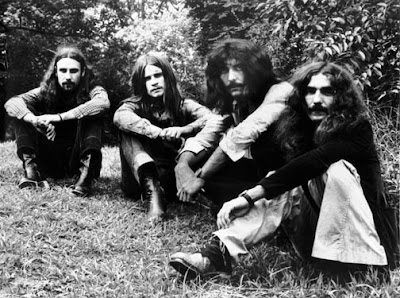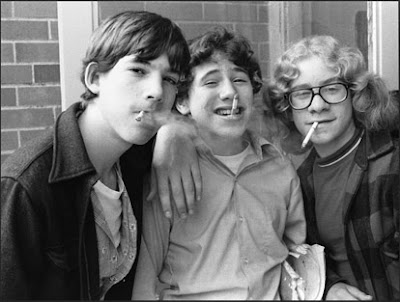>Time for a Swedish post.
I wrote this summary of the Roadburn festival 2009 for Sweden Rock Magazine.
—
Jag tänker fortfarande på Roadburn
av Mattias Indy Pettersson
Det har nu gått en månad sedan Roadburn-festivalen gick av stapeln i lilla Tilburg i lilla Holland, men det har nog inte gått en dag eller natt utan att jag tänkt på eller berörts av festivalen på ett eller annat sätt. Jag tänker fortfarande på Roadburn.
Lördagen den 25 april, precis efter att NEUROSIS har förlöst något av det mäktigaste jag upplevt i hela mitt liv, så står jag där med tårar rinnandes längst kinderna. Folk runtomkring mig skriker i extas långt, långt efter att musiken har tystnat. För ett ögonblick tror jag mig förstå jihad, fanatismen och den religiösa galenskapen, för det här känns ända in i själen. Det är något man aldrig glömmer. När musik berör så djupt så går det inte att stå emot. Man blir en religiös fjant, helt enkelt – och får dåndimpen!
Roadburn presenterar sig själva så här:
This is a gathering of like minded bands and fans from around the world, joined together by a love of music. This is a celebration of tube-driven distortion and crackling electric guitars, a raising of musical consciousness and brotherly and sisterly love, a communion with THEE MIGHTY RIFF, a time and place to get high en mass and bask in the heaviness.
Bättre än så kan inte festivalen beskrivas. Man erhåller en strid ström av upplevelser där det är rena lyxen att kryssa mellan alla godsaker som erbjuds: tre scener under samma tak, fantastiskt ljud, oerhört välarrangerat på alla plan, en hängiven publik, svingrymma band och en obeskrivligt mysig stämning. Fansen är där för att dyrka, banden är där för att frälsa.
Det här året, festivalens tioårsjubileum, kureras lördagen av NEUROSIS, vilket innebär att det är de som bestämmer vilka band som spelar just denna dag. Jag vet inte hur många gånger jag har gått igenom lördagens osannolika spelschema. Startfältet är obeskrivligt bra och NEUROSIS utgör den absoluta höjdpunkten klockan tio på lördagskvällen.
NEUROSIS, ja. Herrejävlar.
Innan giget sätts det upp plakat som varnar för den höga ljudnivån. “Räcker det inte med all hype nu”, hinner jag tänka. När jag sedan står där i världens fetaste torktumlare och kippar efter andan så fattar jag vad de menar. Satan, vilken volym!
Jag är inget större fan av bandets new age-plattor (allt efter 1999 års “Times of Grace”), även om senaste “Given to the Rising” (2007) är fantastisk i sin återgång till det tyngre och brutalare. Men trots att kvällens låtlista nästan uteslutande består av senare material går det inte att motstå bandets enorma kraft. Det är verkligen svinbra.
Enligt spelschemat (som alltid följs strikt discplinerat på den här festivalen) ska de sluta halv tolv, så när en sinnessjukt tung version av “Times of Grace” tonar ut vid den tiden utgår jag ifrån att det hela är över, och jag är förbannat nöjd.
Då ser jag det.
Fyra pukor bärs ut på scenen och en välbekant oljudssampling börjar fräsa i högtalarna. Jag får en flashback till 1996 och Eldslandet i Jönköping, platsen där jag för första gången skådade vad som kom att bli ett av mina absoluta favoritband genom tiderna. NEUROSIS, ett band jag aldrig hade hört talas om då, står på scenen och inleder med att hamra infernaliskt på pukor. “Through Silver in Blood”! Det är bland det tuffaste jag någonsin sett och hört. En oförglömlig upplevelse.
Och nu händer det igen, fjorton år senare.
I ren panik rensar jag blixtsnabbt min kamera på alla dagens bilder och filmklipp och ställer mig i givakt med kameran i filmläge. Det kan vara så att de tänker köra “Through Silver in Blood”.
Och fem sekunder in i nedanstående filmklipp kan man höra min reaktion när jag fattar att det verkligen är den låten som ska framföras. Tårarna rinner som på ett litet barn och det är för mig en gåta hur jag ens lyckades hålla kameran någorlunda stilla. Chocktillstånd, förmodligen.
Men jag går händelserna i förväg. Redan på torsdagen inleds festivalen och det absolut första bandet på lilla scenen (storleksmässigt som Kafé 44 i Stockholm ungefär) visar sig vara det absolut bästa. FARFLUNG från Los Angeles låter som en spacerock-variant av JOY DIVISION, som en roadtrip i rymden, som… jag vet inte vad. Vokalisten står där längst fram och rattar sitt lilla rymdskepp bestående av ett gäng synthar och effekter, och publiken bara gapar, ler fånigt och dyrkar på alla fyra. Jag lyckas filma delar av giget, men fångar inte magin. Hela konserten finns dock att uppleva i strömmande format på följande adress:
http://3voor12.vpro.nl/concerten/
Det absolut sista bandet denna torsdag uppträder även de på lilla scenen, och även här blir jag totalt knockad. Tröttheten var nära att få mig att ge upp och skippa detta, men jag tackar gudarna för att så icke skedde. WHITE HILLS från New York skapar äkta sjuttiotalspsykedelia med en sådan grym närvaro att man tappar brallorna. De första fem minuterna ägnas dock åt typiskt manligt beteende då basisten visar sig vara som tagen från valfri ockult underjordsskräckis från sjuttiotalet. Hon bär plyschdräkt! Och hon är en gudinna rakt uppstigen från helvetet! Snyggheten personifierad. Och hon spelar så jävla coolt. Efter att ha kommit över denna chock upptäcker jag även musiken. Helt fantastiskt. Alla skivor är härmed beställda och jag vet inte hur många gånger jag kollat nedanstående klipp:
Under dagen har jag även beskådat italienska UFOMAMMUT som inledde årets festival. De är svinbra på platta, men live funkade det tyvärr inte alls. Volymen är för låg, låtarna för okarismatiska och trummisen tycks ha en dålig dag.
Rose Kemp, dotter till Maddy Prior och Rick Kemp från bandet STEELEYE SPAN, inleder sitt gig med tjugo minuters krångel om någon lam ljudinställning. När det väl brakar igång är jag duktigt irriterad och kan inte riktigt insupa atmosfären. Hon är en fantastisk sångerska och bandet får verkligen hennes märkliga blandning av singer/songwriter, tung rock, folkprog och psykedelia att lyfta, men efter halva giget lämnar jag lokalen. Mitt följe intygar dock att andra häften av konserten var magisk. Jag betvivlar dem icke.
I stället glider jag över till Green Room, den mellanstora lokalen, och beskådar en orkan, en sjuhelsikes cyklon, i form av amerikanska MINSK som inte låter helt olikt NEUROSIS kring “Times of Grace” emellanåt. När de drar på som mest tvingas man nästan bakåt av ljudväggen – och då lägger de in ytterligare en växel! Och sedan river de ljudväggen med tystnad. Det är imponerande att beskåda.
Ultrakultbandet AMON DÜÜL II, av många ansedda som krautrockens grundare och pionjärer (första plattan, ”Phallus Dei” kom 1969), står på stora scenen och svajar. De är inga ungtuppar direkt, men Renate Knaup håller igång cirkusen och det funkar. Är man ett gammalt fan tror jag att man uppskattar gruppen mer än vad jag gjorde.
Även detta gig går att lyssna på i sin helhet här:
http://3voor12.vpro.nl/concerten/
Norska MOTORPSYCHO övertygar hela första timmen med sin äckligt skickliga blandning av psych, rock, jazz och vilken genre man än kan tänka sig. Min rygg börjar strejka och när jag rör mig runt i lokalen börjar de spela poplåtar. Nog för att viss pop går hem i mitt hem, men inte ikväll. Inte just nu. Trion lirar i ytterligare en och en halv timme, men det finns annat att upptäcka. Jag glider vidare i jakt på mer magi.
Överskattade WOLVES IN THE THRONE ROOM och THE DEVIL’S BLOOD skippar jag med glädje och åkallar istället plyschklädda demoner tillsammans med världens bästa WHITE HILLS. Efter en sån här dag undrar man stillsamt hur fan det ska kunna bli bättre. Det är väl lika bra att åka hem redan efter första dagen? Nästan så.
Tur då att fredagen inte är fullt lika hysterisk i sitt upplägg.
Dagen inleds med fantastiska BOHREN UND DER CLUB OF GORE. Den stora scenen är fullständigt dränkt i mörker, så när som på en minimal spotlight vid varje medlem. Man ser aldrig något annat än deras ansikten, och då endast i ett rökigt dis. Så snyggt! Så suggestivt!
När den Twin Peaks-minnande jazzen sveper genom lokalen och baskaggen (även den upplyst visandes omslaget till senaste skivan “Dolores”) mullrar så det fläktar kring öronen är det bara att luta sig tillbaka och njuta. En bättre början på dagen är svår att tänka sig. För kamrat Martin Hallin, tidigare vokalist i black metal-konstellationen NEPHENZY CHAOS ORDER, är detta festivalens absoluta höjdpunkt. In i dimman, in i mörket…
Direkt efter tyskarna så kliver gamla klassiska ANGEL WITCH upp på scenen. Kontrasten är total och väldigt välkommen. Mitt bland all ”svår” musik är det skönt med äkta, renrasig heavy metal, och jag tror ingen blev särskilt besviken. Spelglädjen hos britterna går nästan att ta på och folk headbangar loss totalt.
Fler nedslag i väntan på SAINT VITUS:
VIBRAVOID lyckas bra med sin psychrymdrock (hur många effektpedaler kan man koppla samman egentligen?). Japanska MONO förtrollar som alltid. Alla gånger jag har sett CATHEDRAL har jag somnat stående efter två låtar, så jag avböjer deras invit denna gång.
Och så äntligen SAINT VITUS då.
De ser så sjukt coola ut att man knappt tror det är sant. Wino är så jävla hårdrock. Och han allena håller samman setet, för de andra är ute och cyklar på fattiga Elgiganten-cyklar mest hela tiden. Så är det faktiskt. Visst, SAINT VITUS är inget jävla DREAM THEATER gällande spelskicklighet, och de är verkligen inget BLACK SABBATH gällande komponerande, men nån hejd på kackigheten får det väl ändå vara? Kommer Armando in på ettan en enda gång? Tveksamt. Vad pysslar Dave Chandler med? Ingen som vet. Hans gitarrsolo är fantastiskt i all sin tafflighet, och när sedan Armando avlöser honom med ett ”trumsolo” som får hela Spinal Tap-filmen att radera sig själv från masterbandet så tycker jag nästan synd om gubbarna och de fanatiska fansen som enträget står och tokhyllar. Men det är ändå coolt på nåt sätt. Det är SAINT VITUS-coolt.
Trots det väljer jag att gå på upptäcksfärd och hamnar mot all vett och sans framför ett band vid namn DRAGONTEARS (!) från Danmark (!!). Jag likställer ju power metal med dansbandsmusik och schlager. Vad är det som händer?
Men trots det ultrasunkiga bandnamnet är dessa danskar årets överraskning. Jag tror de kör två låtar under hela konserten, och vi snackar således långa, utdragna jamsessions där det psykedeliska aldrig tycks ta slut. Vi som är där dras in i en av många transer och vägrar ge upp. Deras album ”Tambourine Freak Machine” rekommenderas å det varmaste.
Det lät och såg ut ungefär så här:
Lördag. Den stora NEUROSIS-dagen!
GRAILS inleder med ett schysst set som kanske aldrig riktigt lyfter utöver det vanliga, men som tveklöst får mig att bege mig till deras gratisspelning några dagar senare i Stockholm. Att de sömlöst byter instrument med varandra ett flertal gånger under konsertens gång visar bandets bredd. Bör upplevas!
EARTH, som jag sett några dagar innan i Stockholm (och som du kan läsa en intervju med här), och som jag därför inbillar mig kunna undvara till förmån för nya upptäckter, är enormt svåra att motstå på den stora scenen. Helt plötsligt går tillvaron i slow motion och man tror sig befinna sig mitt ute i den amerikanska öknen. På riktigt. Den effekten har EARTH på mig. Fantastiskt och galet.
Vidare till Eugene Robinson, en stor svart kille som är känd för sina åsikter om… slagsmål. Han har till och med skrivit en bok betitlad “Fight” (rekommenderas varmt till fightingfans, MMA-dyrkare osv…). Han sjunger även i konstighetsrockbandet OXBOW. På Roadburn står han ensam på scenen och berättar anekdoter från sin uppväxt som kantats av våld. Han verkar inte helt pålitlig i sitt agerande och det är med viss spänning som jag står längst fram. En rullstolsbunden kille har helt plötsligt mikrofonstativet i knät. Det är en tryckt stämning i lokalen och jag gillar det skarpt.
Efter sitt spoken word-framträdande får han sällskap av bandet BLACK SUN och tillsammans kör de ett improviserat nummer som stinker av svett, ilska och energi. Sannerligen ett udda inslag även på en festival som Roadburn.
En av festivalens höjdpunkter (det finns hur många som helst!) är tveklöst OM, en duo som nöjer sig med bas och trummor. Al Cisneros, som till vardags tjänar sitt uppehälle som schacklärare, tidigare i mäktiga SLEEP, och Emil Amos (även i GRAILS) ser så otroligt sköna ut på den stora scenen att man blir glad bara av åsynen. När de börjar lira… Jösses! De låter fullständigt magiska tillsammans. Kanske att Amos borde hejda sig lite i sitt trumvirvlande – musiken bygger faktiskt på transframkallande minimalism – men vad fan, det får gå. Man ger sig hän. När “At Giza” kickar igång njuter nära tvåtusen personer i full beundran. De avverkar en ny låt som är fullständigt grym och som jag fångar på film, men några dagar senare får jag mail från Al där han vänligt ber mig ta bort klippet från YouTube. När skivan kommer ut åker det förhoppningsvis upp igen.
Jag vägrar bryta OM-transen och missar således början av U.S. CHRISTMAS, ett av de band jag verkligen sett fram emot. Samtidigt vill jag ha bästa möjliga plats inför NEUROSIS som börjar samtidigt som U.S. CHRISTMAS slutar. Å, dessa förbannade krockar!
Jag väljer sålunda att stanna kvar efter OM och påbörjar min mentala förberedelse inför festivalens katarsis. Men trots att jag missar U.S. CHRISTMAS är jag nöjd ändå. NEUROSIS dög som bekant. Ytterligare några band spelade efter deras monumentala ångvältsgig, men jag orkade inte mer. Man vill inte dö riktigt än.
Jag tänker redan på nästa års Roadburn…
Länkar av värde:
http://roadburn.wordpress.com/
http://3voor12.vpro.nl/concerten/
http://nymoral.blogspot.com/
























